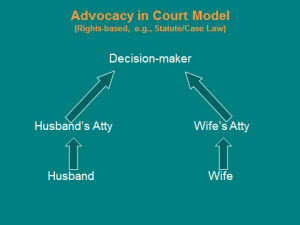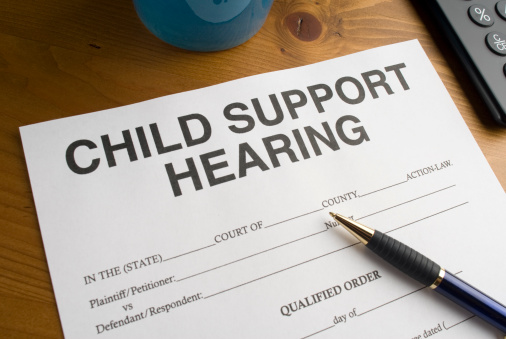
Potential divorce clients often ask, how much does a collaborative divorce cost? Great question, it differs with each case and is dependent on clients and their level of conflict regardless of process. The more conflict a couple brings to any divorce process the more expensive it will be. Bottom line, conflict is expensive. Butting heads together to argue positions vs. putting heads together to solve problems will always increase costs. In a
collaborative divorce, we focus on putting heads together which should decrease costs.
As a financial neutral in the collaborative process, I have given this cost question serious thought. I wrestle with how you define cost. Do we measure cost only in terms of dollars and cents or is there something beyond the almighty dollar? I think the latter.
I remember a couple who owned a business that I worked with in a collaborative divorce. By simply suggesting an alternative to using retirement fund money (client plan) to pay off a rather large debt, I was able to save them about $9,000 in income taxes. I seriously doubt anyone other than a well-trained financial professional would have noticed this.
What about the cost savings of better-adjusted children of divorce because of their parents taking a higher road with less tension and conflict allowing both parents to effectively co-parent to create and environment where children are not placed in the middle of parental conflict? What about the cost of the stress and delays that typically occur with a traditional court based divorce? How do you place a number on the cost of destroyed relationships with spouses, children, extended family members such as in-laws and friends? How can one put a dollar value on these?
Theoretically, a collaborative divorce should cost less. Attorney involvement in a collaborative divorce is typically less than in a traditional court based model. This occurs since other professionals, usually at lower hourly rates, provide many services historically provided by attorneys.
Some attorneys choose not to become collaborative divorce practitioners because of this. Some traditional court based attorneys will say they do not believe that it is in the best interest of their client to have to withdraw from representing their client if the case does not settle in the collaborative process. The withdrawal provision if a case should go to court, is a key feature of collaborative divorce because it places everyone’s focus and interests, attorneys and clients, on finding solutions that take into account the highest priorities of both spouses and their children instead of arguing positions ad infinitum. This committed agreement for attorneys and clients to settle is, in my opinion, a good thing for divorcing spouses. It helps provide the framework for a less costly divorce and as I said earlier, I am not talking only about money.
One of my goals working with couples or individuals is to reduce their divorce costs whenever and wherever we can so the family can keep more of its hard-earned money. One very simple illustration of how a
financial neutral helps lower costs is in gathering financial information necessary for any divorce. It works like this. The financial neutral gathers All the financial documents from the clients that attorneys will ultimately need such as ALL assets and liability account statements including bank and credit card statements, non-retirement investments and savings, pension and retirement accounts, real estate documents, business documents if any, tax returns, pay check stubs etc.
The financial neutral then, organizes and presents all of this information to both attorneys. Contrast this with each client having to provide all of this information to each of their attorneys. Attorneys usually have the highest hourly rates. Rather than paying two attorneys the couple pays, one financial professional, to perform this function. This one-step in the process can easily save a couple up to two thousand dollars.
When minor children are involved, a
neutral child specialist will meet with the parents to help them create parenting plans that are in the best interest of the child. The child specialist usually conducts these meetings without an attorney present.
A neutral coach, when engaged by a couple, meets with the clients without attorneys to facilitate communication plans throughout the divorce process and looking ahead in the couple’s relationship post divorce.
The child specialist and neutral coaches typically have the lowest hourly rates in the process of all professionals. Sometimes clients choose not to hire a neutral coach. In my experience, having a coach on board can help decrease tension and improve communication between spouses during the process. Less tension and conflict should lead to lower cost and more importantly stronger relationships post divorce.
Well, I really have not given you a definitive answer on how much a collaborative divorce costs, because I cannot. Every couple and family is unique. Couples themselves determine, often unconsciously, how much their divorce will cost. Cost is directly a function of the level of conflict they bring into and maintain throughout the process.
Ultimately, I think it boils down to what the couple wants. If they want a largely attorney driven process and someone else to make decisions for them about their children and their future then perhaps the more traditional court based process is for them. If on the other hand the couple wants to have less attorney involvement, make decisions for themselves and their children instead of someone else deciding then a collaborative divorce may be a better choice.
If I could leave you with anything from this post, it would be to remember theoretically a collaborative divorce should cost less and that cost is more than just money. You control your journey and your destination. Choose wisely.
 When you find out your son or daughter is getting a divorce, your first thought will often be about their children; your grandchildren. How will the children be affected by all of this? And how can you help; or avoid hurting the situation?
During the 31 years I have been working with divorcing families, I have seen situations where the grandparents have really helped their children and grandchildren though a difficult time. Sadly however, I have witnessed far more situations where they grandparents have, without realizing it, actually make the divorce more difficult for their grandchildren.
You may be wondering; how can this be? What type of person would actually make the divorce more difficult for their grandchildren? Believe it or not, it can happen to the very best grandparents without them even realizing it. Here are the two common mistakes that grandparents make:
When you find out your son or daughter is getting a divorce, your first thought will often be about their children; your grandchildren. How will the children be affected by all of this? And how can you help; or avoid hurting the situation?
During the 31 years I have been working with divorcing families, I have seen situations where the grandparents have really helped their children and grandchildren though a difficult time. Sadly however, I have witnessed far more situations where they grandparents have, without realizing it, actually make the divorce more difficult for their grandchildren.
You may be wondering; how can this be? What type of person would actually make the divorce more difficult for their grandchildren? Believe it or not, it can happen to the very best grandparents without them even realizing it. Here are the two common mistakes that grandparents make:








 Peace is possible though we are surrounded by high conflict. In the recent words of former Secretary of State Madeleine Albright, “The world is a mess.” Messiness occurs when people are unable or unwilling to resolve differences without wars of words or weapons. This occurs not only globally but also on a personal scale. And for all the extraordinary human costs of violent conflict, the most deeply distressing is its impact on children.
The end of a marriage is not unlike the breaking up of a country based on sectarian differences. Is it possible to disconnect without civil war? Yes, but one must be mindful of the path one is choosing, and deliberately opt to not do battle. Though sometimes complicated, peaceful resolutions are possible if the focus remains the safety and wellbeing of children.
I do not believe conflict is inevitable, because for every cause of conflict there is an inverse possibility. In our day-to-day lives, we can choose a path of peace. We can elect to follow
Peace is possible though we are surrounded by high conflict. In the recent words of former Secretary of State Madeleine Albright, “The world is a mess.” Messiness occurs when people are unable or unwilling to resolve differences without wars of words or weapons. This occurs not only globally but also on a personal scale. And for all the extraordinary human costs of violent conflict, the most deeply distressing is its impact on children.
The end of a marriage is not unlike the breaking up of a country based on sectarian differences. Is it possible to disconnect without civil war? Yes, but one must be mindful of the path one is choosing, and deliberately opt to not do battle. Though sometimes complicated, peaceful resolutions are possible if the focus remains the safety and wellbeing of children.
I do not believe conflict is inevitable, because for every cause of conflict there is an inverse possibility. In our day-to-day lives, we can choose a path of peace. We can elect to follow 

